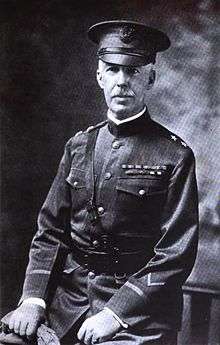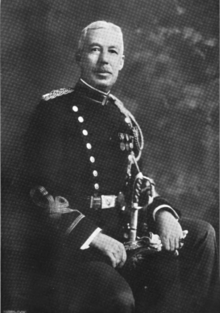George H. Cameron
| George Hamilton Cameron | |
|---|---|
 | |
| Born |
January 8, 1861 Ottawa, Illinois |
| Died |
January 28, 1944 (aged 83) Staunton, Virginia |
| Buried at | Arlington National Cemetery |
| Allegiance |
|
| Service/branch |
|
| Years of service | 1883–1924 |
| Rank |
|
| Unit |
7th Cavalry Regiment 4th Cavalry Regiment |
| Commands held |
|
| Battles/wars |
American Indian Wars Spanish–American War World War I |
| Awards |
British Order of the Bath French Croix de Guerre French Legion of Honor |
| Relations |
Nina Dean Tilford (1864–1960) (wife) Douglass Tilford Cameron (1894–1918) (son) Nina (1896–1965) (daughter) Margaret (1898–1984) (daughter) |
George Hamilton Cameron (January 8, 1861 – January 28, 1944) was a Major General in the United States Army.
Early life
George H. Cameron was born in Ottawa, Illinois on January 8, 1861. He attended Northwestern University, where he joined the Phi Kappa Sigma fraternity. In 1879 he began at the United States Military Academy. His classmates included Clarence Ransom Edwards and Omar Bundy, and he graduated in 1883 with a commission as a Second Lieutenant of Cavalry.[1][2][3]
Start of career
Cameron's early assignments during the American Indian Wars were with the 7th Cavalry Regiment (1883 to 1891), including postings to Fort Meade, South Dakota. His subsequent assignments included the 4th Cavalry Regiment (1891 to 1895). While assigned to the 7th and 4th Cavalry, Cameron was also an instructor at the U.S. Military Academy (1888 to 1895).[4][5]
From 1895 to 1898 he served with the 4th Cavalry at Fort Walla Walla, including assignment as the regimental quartermaster.[6]
Cameron served on Luzon in the Philippines during the Spanish–American War, commanding A Troop, 4th Cavalry.[7]
He was Secretary of the Cavalry and Field Artillery School of Application at Fort Riley from 1901 to 1906, and Assistant Commandant of the Mounted Service School at Fort Riley from 1907 to 1910.[8][9]
He served with the 14th Cavalry Regiment in the Philippines from 1910 to 1912, and commanded the Big Bend District in Texas in 1913, during the events which led to the Pancho Villa Expedition.[10][11]
In 1913 he completed the Field Officers' Course. He was a student at the Army War College from 1913 to 1914, and was the Director of the War College from 1914 to 1916.[12]
World War I

Cameron was assigned to command the Maneuver Camp at Fort Benjamin Harrison at the start of U.S. preparation for entry into World War I. He subsequently organized officer training in the Army's Southern Department, and then commanded the 5th Cavalry Regiment.[13]
In 1917 he was assigned to command of the 3rd Brigade in the Army's 15th Cavalry Division. When the plan to field Cavalry divisions was dropped in favor of creating all Infantry divisions, Cameron was assigned as commander of the 25th Cavalry Regiment.[14]
Cameron was promoted to temporary Brigadier General and briefly commanded 78th Infantry Brigade, 39th Infantry Division and 80th Brigade, 40th Infantry Division. From September to December 1917 he commanded the 40th Infantry Division.[15][16][17]
He was promoted to temporary Major General in December 1917 and assigned to command of the 4th Infantry Division. He was the division's first commander, and led it from its organization at Camp Greene, North Carolina through most of 1918, including the Saint-Mihiel Campaign and the start of the Meuse-Argonne Campaign. He is also credited with designing the division’s shoulder sleeve insignia.[18][19][20]
From August to October 1918 Cameron commanded the V Corps, and led it during the latter portion of the Meuse-Argonne campaign. He was relieved after the Battle of Montfaucon, supposedly because V Corps did not accomplish their objective on the first day of fighting, but possibly because he argued with Hugh Drum.[21][22]
(John J. Pershing was attempting to simultaneously command First Army and the American Expeditionary Forces. As First Army Chief of Staff, Drum, then a Colonel, was at times its de facto commander. During the Battle of Montfaucon, he pressed Cameron during a phone call, and Cameron told him "you can't talk to me like that." Cameron was of the view that Drum reported the conversation to Pershing, and that it led to Cameron's relief.)[23][24][25][26]
In October 1918 he was succeeded at V Corps by Charles P. Summerall, a Pershing protégé, and returned to command of the 4th Division. Later in October Cameron was designated to return to the United States to organize and train additional units for fighting in France, but the end of the war eliminated the need for more soldiers.[27][28][29]
Post World War I

After the war Cameron was assigned to command of Camp Gordon, Georgia. In 1919 he reverted to the permanent rank of Colonel and was appointed to command of the Cavalry School at Fort Riley.[30][31][32]
In 1921 Cameron was named Chief of Staff of the 76th Infantry Division, and served until his 1924 retirement.[33][34][35]
Awards
Cameron's awards and decorations included the British Order of the Bath (Companion), French Croix de Guerre, and France’s Legion of Honor (Commander).[36]
Retirement, death and burial
After retiring, Cameron resided on Fishers Island, New York until moving to Staunton, Virginia late in his life.[37]
He was promoted to Major General on the retired list in 1930.[38]
He died in Staunton on January 28, 1944.[39] He was buried at Arlington National Cemetery, Section 6, Grave 5700.[40]
Family
In 1888, Cameron married Nina Dean Tilford (1864–1960). She was the daughter of Brigadier General Joseph G. Tilford and sister of Colonel James D. Tilford, Sr.
George and Nina Cameron's children included: Douglass Tilford Cameron, who was a First Lieutenant in the Army when he was killed in France during World War I; Nina (1896-1965), the wife of Brigadier General John B. Thompson (1890–1957); and Margaret (1898–1984), the wife of Colonel Buckner M. Creel (1896-1981), who served as commandant of Staunton Military Academy after retiring from the Army.[41][42][43][44]
References
- ↑ United States Army Adjutant General, U.S. Army Recruiting News, 1940, page 1
- ↑ Michael E. Shay, Revered Commander, Maligned General: The Life of Clarence Ransom Edwards, 2011, page 9
- ↑ College Fraternities Publications, Baird's Manual of American College Fraternities, 1912, page 288
- ↑ George Washington Cullum, Biographical Register of the Officers and Graduates of the United States Military Academy, Volume 3, 1891, pages 371–372
- ↑ George Washington Cullum, Edward Singleton Holden, , Supplement to Volume V, 1910, page 346
- ↑ Army and Navy Journal, Courts Martial, July 17, 1897
- ↑ George H. Cameron, U.S. Cavalry Association Journal, The Fourth Cavalry with General Lawton in Luzon, Volume VX, July 1904 to July 1905, page 611
- ↑ United States Congressional Serial Set, Issue 5274 Report of the School of Application for Cavalry and Field Artillery, Volume V, 1907, page 268
- ↑ United States Congress, Credit to the Accounts of George H. Cameron, 1910, pages 67–70
- ↑ Army and Navy Register, Assails U. S. Troops, June 21, 1913, page 786
- ↑ U. S. Army, General Orders and Circulars Issued from Headquarters, Philippine Division, 1911, page 35
- ↑ George Washington Cullum, Biographical Register of the Officers and Graduates of the United States Military Academy, Volume 6, Part 1, 1920, page 359
- ↑ George Washington Cullum, Biographical Register of the Officers and Graduates of the United States Military Academy, Volume 6, Part 1, 1920, page 359
- ↑ West Point Association of Graduates, Memorial, George H. Cameron 1883, retrieved March 17, 2014
- ↑ Army and Navy Register, Late Army Orders, October 27, 1917
- ↑ George Washington Cullum, Biographical Register of the Officers and Graduates of the United States Military Academy, Volume 6, Part 1, 1920, page 359
- ↑ C. S. Hutson & Co., History of the Fortieth (Sunshine) Division, 1920, pages 30, 61, 65, 162
- ↑ Shipley Thomas, The History of the A. E. F., 1920, page 455
- ↑ Christian Albert Bach, Henry Noble Hall, The Fourth Division: Its Services and Achievements in the World War, 1920, page 29
- ↑ Floyd Phillips Gibbons, And They Thought We Wouldn't Fight, 1918, page 401
- ↑ Byron Farwell, Over There: The United States in the Great War, 1917-1918, 2000, page 226
- ↑ Spencer Tucker, U.S. Leadership in Wartime: Clashes, Controversy, and Compromise, Volume 1, 2009, page 476
- ↑ Edward M. Coffman, The War to End All Wars: The American Military Experience in World War I, pages 256, 304, 330, 368, 375
- ↑ William M. Wright, author, Robert H. Herrell, editor, Meuse-Argonne Diary: A Division Commander in World War I, page 69
- ↑ William S. Triplet, A Youth in the Meuse-Argonne: A Memoir, 1917-1918, 2000, page 311
- ↑ Anne Cipriano Venzon, Paul L. Miles, editors, The United States in the First World War: An Encyclopedia, 1999, page 118
- ↑ Arthur Wilson Page, Our 110 Days' Fighting, 1920, page 100
- ↑ New York Times, The New York Times Current History: The European War, Volume 19, 1919, page 527
- ↑ John Votaw, The American Expeditionary Forces in World War I, 2013, Retrospective
- ↑ Mole & Thomas, Library of Congress Prints and Photographs Division, Photo Description, The Human American Eagle, retrieved March 17, 2014
- ↑ George H. Cameron, The Cavalry Journal, Revision of Regulations, January 1921, page 6
- ↑ United States War Department, Annual Report of the Secretary of War: The Cavalry School, 1921, page 236
- ↑ Infantry Journal, Reserve Officers’ Department, July 1922, page 358
- ↑ United States Military Academy Association of Graduates, Annual Report, 1925, page 319
- ↑ Charles Pelot Summerall, The Way of Duty, Honor, Country: The Memoir of General Charles Pelot Summerall, 2010, page 257
- ↑ U.S. Army Adjutant General, Life of the Soldier and the Airman, Volumes 22-23, 1940, page 3
- ↑ Fort Griswold & Groton Monument Commission, Sesquicentennial of the Battle of Groton Heights and the burning of New London, Connecticut, 1931, page 62
- ↑ Charles Pelot Summerall, The Way of Duty, Honor, Country: The Memoir of General Charles Pelot Summerall, 2010, page 257
- ↑ Providence Journal Company, Journal-Bulletin Almanac, 1945, page 290
- ↑ U.S. National Cemetery Interment Control Forms, 1928-1962, entry for George H Cameron, retrieved March 17, 2014
- ↑ Robert Lee, Fort Meade and the Black Hills, 1991, page 89
- ↑ Army and Navy Journal, Inc., Army and Navy Journal, 1942, page 22
- ↑ Army and Navy Journal Incorporated, Army, Navy, Air Force Journal, Volume 97, Issues 27-52, 1960, page 990
- ↑ New York Times, Lieut. D.G. Cameron Slain; Was Only Son of Major General, December 2, 1918